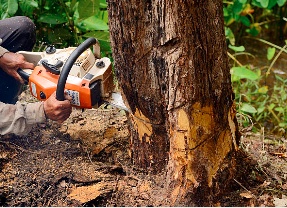Tree stump removal is a crucial aspect of landscaping and property maintenance that is often overlooked. Whether you've recently had a tree removed from your yard or inherited an unsightly stump on your property, addressing it promptly can significantly enhance the aesthetics and safety of your outdoor space. In this comprehensive guide, we'll explore various methods of tree stump removal, cost considerations, environmental impact, safety measures, and more to help you make informed decisions about managing tree stumps on your property.
Methods of Tree Stump Removal
Chemical Removal
Chemical stump removal involves the use of specialized solutions to accelerate the decomposition of the stump. These solutions are applied directly to the stump, gradually breaking it down over time. While chemical removal can be effective, it requires patience as it can take several weeks or even months to fully eliminate the stump. Additionally, some chemical solutions may pose environmental concerns and require careful handling.
Grinding
Stump grinding is a popular method that involves using a specialized machine to grind the stump into small wood chips. This process is relatively quick and efficient, making it a preferred choice for many homeowners. However, stump grinding may leave behind sawdust and wood chips that need to be disposed of properly. Furthermore, it may not eliminate the entire root system, leading to potential regrowth.
Manual Removal
Manual stump removal entails digging around the stump and cutting through the roots using various tools such as axes, saws, and shovels. While this method can be labor-intensive, it allows for precise removal and ensures that the entire stump and root system are eliminated. However, manual removal is best suited for small stumps, and larger ones may require professional assistance.
Cost Considerations
The cost of tree stump removal can vary depending on several factors, including the size of the stump, accessibility, and chosen removal method. On average, homeowners can expect to pay anywhere from $75 to $1000 per stump. Chemical removal tends to be the most affordable option, while professional stump grinding services may incur higher costs.
DIY vs. Professional Services
Deciding whether to tackle stump removal yourself or hire a professional service depends on various factors, including your budget, time constraints, and level of expertise. While DIY methods can save money, they may not always deliver the same results as professional services, particularly for large or stubborn stumps. Professional stump removal services have the necessary equipment and expertise to safely and efficiently remove stumps of any size.
Environmental Impact
When choosing a stump removal method, it's essential to consider the environmental impact. Chemical solutions may contain harmful ingredients that can leach into the soil and groundwater, posing risks to plants and wildlife. Stump grinding produces wood chips that can be reused as mulch or compost, minimizing waste. Manual removal is the most environmentally friendly option but requires considerable physical effort.
Safety Measures
Safety should be a top priority during stump removal to prevent accidents and injuries. It's essential to wear protective gear, including gloves, safety goggles, and sturdy footwear. When using power tools or machinery, follow manufacturer instructions and exercise caution. Be mindful of underground utilities and other obstacles that may be hidden beneath the surface.
Post-Removal Care
Once the stump has been removed, take steps to restore the area and promote healthy growth. Fill the hole left by the stump with topsoil and plant grass or flowers to rejuvenate the landscape. Consider installing a barrier around the area to prevent tripping hazards and protect surrounding vegetation.
Benefits of Stump Removal
Removing tree stumps offers numerous benefits beyond aesthetics. It eliminates potential safety hazards such as tripping and mowing accidents, making your outdoor space safer for family and visitors. Stump removal also prevents the spread of diseases and pests that can affect neighboring trees and plants, preserving the overall health of your landscape.
Common Challenges
Despite the benefits of stump removal, homeowners may encounter challenges, particularly with older or larger stumps. Stubborn stumps may have extensive root systems that require additional effort to extract fully. In some cases, professional assistance may be necessary to ensure thorough removal and prevent damage to surrounding property.
Local Regulations
Before embarking on a stump removal project, it's essential to check local regulations regarding tree removal and landscaping activities. Some areas may require permits for tree removal or have restrictions on certain removal methods. Compliance with these regulations is crucial to avoid fines and legal issues.
Alternative Uses for Stumps
Instead of removing stumps entirely, consider repurposing them for decorative or functional purposes. Stumps can be turned into natural seating, planters, or even works of art with some creativity and craftsmanship. Leaving stumps in place can also provide habitat for wildlife and contribute to the biodiversity of your yard.
Case Studies
Here are some real-life examples of successful stump removal projects:
- Case Study 1: A homeowner in suburban area hired professional stump grinding services to remove several large stumps from their backyard, resulting in a safer and more spacious outdoor space for their children to play.
- Case Study 2: A commercial property owner utilized chemical stump removal methods to eliminate numerous stumps along a walking path, improving the aesthetics and accessibility of the area.


No comments yet